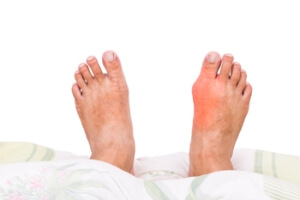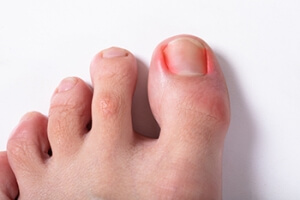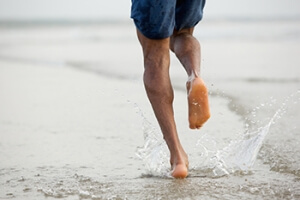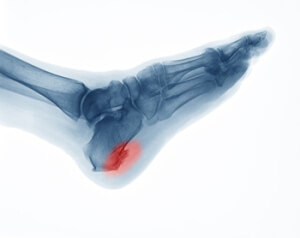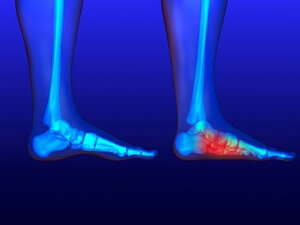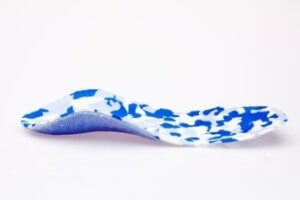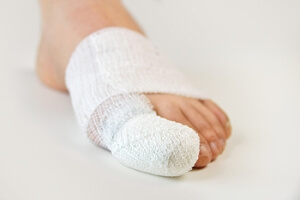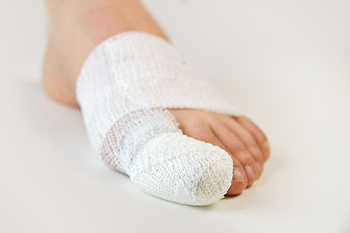Super User
What Can Cause Bunions?
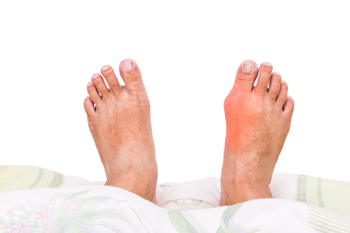 There are many potential causes of bunions. Foot injuries, such as sprains, fractures, or nerve damage can increase the risk of developing bunions. Some people are born with defects in the structure of their foot that lead to bunion formation later on. Bunions also tend to run in families. Certain structural problems in the feet, such as loose joints and tendons, flat feet, and low arches can make bunions more likely to form. Bunions are also linked to rheumatoid arthritis. To learn more about bunions, please consult with a podiatrist.
There are many potential causes of bunions. Foot injuries, such as sprains, fractures, or nerve damage can increase the risk of developing bunions. Some people are born with defects in the structure of their foot that lead to bunion formation later on. Bunions also tend to run in families. Certain structural problems in the feet, such as loose joints and tendons, flat feet, and low arches can make bunions more likely to form. Bunions are also linked to rheumatoid arthritis. To learn more about bunions, please consult with a podiatrist.
If you are suffering from bunions, contact one of our podiatrists of New Tampa Foot & Ankle. Our doctors can provide the care you need to keep you pain-free and on your feet.
What Is a Bunion?
A bunion is formed of swollen tissue or an enlargement of boney growth, usually located at the base joint of the toe that connects to the foot. The swelling occurs due to the bones in the big toe shifting inward, which impacts the other toes of the foot. This causes the area around the base of the big toe to become inflamed and painful.
Why Do Bunions Form?
Genetics – Susceptibility to bunions are often hereditary
Stress on the feet – Poorly fitted and uncomfortable footwear that places stress on feet, such as heels, can worsen existing bunions
How Are Bunions Diagnosed?
Doctors often perform two tests – blood tests and x-rays – when trying to diagnose bunions, especially in the early stages of development. Blood tests help determine if the foot pain is being caused by something else, such as arthritis, while x-rays provide a clear picture of your bone structure to your doctor.
How Are Bunions Treated?
- Refrain from wearing heels or similar shoes that cause discomfort
- Select wider shoes that can provide more comfort and reduce pain
- Anti-inflammatory and pain management drugs
- Orthotics or foot inserts
- Surgery
If you have any questions, please feel free to contact our office located in Wesley Chapel, FL . We offer the newest diagnostic and treatment technologies for all your foot care needs.
Ingrown Toenails 101
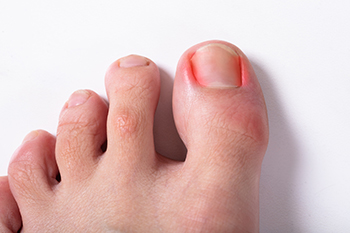 An ingrown toenail occurs when the toenail curls and grows into the skin surrounding the nail. Ingrown toenails usually become painful, red and swollen, and if left untreated, they can become infected. Common situations that cause ingrown toenails include wearing tight fitting shoes, improperly cutting the toenails, having sweaty feet, or sustaining a toe injury. If you are struggling with an ingrown toenail, soaking the feet in warm water for 15-20 minutes, 3-4 times a day is recommended. However, if the ingrown toenail persists, it is important to have it checked by a podiatrist in order to prevent an infection. In severe cases, a podiatrist may need to remove the nail via surgery.
An ingrown toenail occurs when the toenail curls and grows into the skin surrounding the nail. Ingrown toenails usually become painful, red and swollen, and if left untreated, they can become infected. Common situations that cause ingrown toenails include wearing tight fitting shoes, improperly cutting the toenails, having sweaty feet, or sustaining a toe injury. If you are struggling with an ingrown toenail, soaking the feet in warm water for 15-20 minutes, 3-4 times a day is recommended. However, if the ingrown toenail persists, it is important to have it checked by a podiatrist in order to prevent an infection. In severe cases, a podiatrist may need to remove the nail via surgery.
Ingrown toenails may initially present themselves as a minor discomfort, but they may progress into an infection in the skin without proper treatment. For more information about ingrown toenails, contact one of our podiatrists of New Tampa Foot & Ankle. Our doctors can provide the care you need to keep you pain-free and on your feet.
Ingrown Toenails
Ingrown toenails are caused when the corner or side of a toenail grows into the soft flesh surrounding it. They often result in redness, swelling, pain, and in some cases, infection. This condition typically affects the big toe and may recur if it is not treated properly.
Causes
- Improper toenail trimming
- Genetics
- Improper shoe fitting
- Injury from pedicures or nail picking
- Abnormal gait
- Poor hygiene
You are more likely to develop an ingrown toenail if you are obese, have diabetes, arthritis, or have any fungal infection in your nails. Additionally, people who have foot or toe deformities are at a higher risk of developing an ingrown toenail.
Symptoms
Some symptoms of ingrown toenails are redness, swelling, and pain. In rare cases, there may be a yellowish drainage coming from the nail.
Treatment
Ignoring an ingrown toenail can have serious complications. Infections of the nail border can progress to a deeper soft-tissue infection, which can then turn into a bone infection. You should always speak with your podiatrist if you suspect you have an ingrown toenail, especially if you have diabetes or poor circulation.
If you have any questions, please feel free to contact our office located in Wesley Chapel, FL . We offer the newest diagnostic and treatment technologies for all your foot care needs.
Understanding Cuboid Syndrome
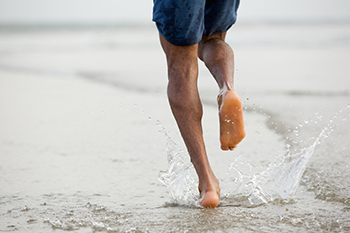 Cuboid syndrome is a partial dislocation of the bones in the middle of the foot. While cuboid syndrome is typically the result of overuse or injury, pronated feet (feet that turn inward when walking), training on uneven surfaces, poorly fitted shoes, and climbing stairs can all be contributing factors as well . A common sign of cuboid syndrome is pain on the outside of the foot near the little toe. Pain may also be felt in the middle of the foot, or at the base of the fourth and fifth toes. Since the pain is sometimes difficult to pinpoint, cuboid syndrome is often confused with a stress fracture. Other symptoms can include difficulty walking, swelling, pain that becomes worse with weight-bearing, and increased pain when lifting the heel and pushing off the toe. If you are experiencing any pain in the foot it is highly recommended to consult with a podiatrist for a proper diagnosis and treatment.
Cuboid syndrome is a partial dislocation of the bones in the middle of the foot. While cuboid syndrome is typically the result of overuse or injury, pronated feet (feet that turn inward when walking), training on uneven surfaces, poorly fitted shoes, and climbing stairs can all be contributing factors as well . A common sign of cuboid syndrome is pain on the outside of the foot near the little toe. Pain may also be felt in the middle of the foot, or at the base of the fourth and fifth toes. Since the pain is sometimes difficult to pinpoint, cuboid syndrome is often confused with a stress fracture. Other symptoms can include difficulty walking, swelling, pain that becomes worse with weight-bearing, and increased pain when lifting the heel and pushing off the toe. If you are experiencing any pain in the foot it is highly recommended to consult with a podiatrist for a proper diagnosis and treatment.
Cuboid syndrome, also known as cuboid subluxation, occurs when the joints and ligaments near the cuboid bone in the foot become torn. If you have cuboid syndrome, consult with one of our podiatrists from New Tampa Foot & Ankle. Our doctors will assess your condition and provide you with quality foot and ankle treatment.
Cuboid syndrome is a common cause of lateral foot pain, which is pain on the outside of the foot. The condition may happen suddenly due to an ankle sprain, or it may develop slowly overtime from repetitive tension through the bone and surrounding structures.
Causes
The most common causes of cuboid syndrome include:
- Injury – The most common cause of this ailment is an ankle sprain.
- Repetitive Strain – Tension placed through the peroneus longus muscle from repetitive activities such as jumping and running may cause excessive traction on the bone causing it to sublux.
- Altered Foot Biomechanics – Most people suffering from cuboid subluxation have flat feet.
Symptoms
A common symptom of cuboid syndrome is pain along the outside of the foot which can be felt in the ankle and toes. This pain may create walking difficulties and may cause those with the condition to walk with a limp.
Diagnosis
Diagnosis of cuboid syndrome is often difficult, and it is often misdiagnosed. X-rays, MRIs and CT scans often fail to properly show the cuboid subluxation. Although there isn’t a specific test used to diagnose cuboid syndrome, your podiatrist will usually check if pain is felt while pressing firmly on the cuboid bone of your foot.
Treatment
Just as the range of causes varies widely, so do treatments. Some more common treatments are ice therapy, rest, exercise, taping, and orthotics.
If you have any questions, please feel free to contact our office located in Wesley Chapel, FL . We offer the newest diagnostic and treatment technologies for all your foot care needs.
Cuboid Syndrome
Cuboid syndrome mostly affects athletes, although it can affect non-athletes too. It is also known as cuboid subluxation or cuboid fault syndrome. This condition occurs when joints and ligaments near the cuboid bone of the foot are damaged, or when the cuboid bone itself is dislodged from its natural position. It is usually marked by pain on the outer side of the foot, which may be persistent or may come and go. Cuboid syndrome can be difficult to diagnose unless it becomes severe and more noticeable. Your doctor will likely ask questions about when the pain began and how long it has been present, and will put pressure on the cuboid bone to determine if that area is the origin of the pain.
Causes of Cuboid Syndrome
- Any repetitive stresses placed on the foot due to athletic activities are a common cause of cuboid syndrome.
- Although it develops over time, it is possible that this syndrome can occur all of sudden due to a single event or injury.
- Over-pronation can exacerbate the condition if not corrected.
Disagreements Amongst Podiatrists Regarding Cuboid Syndrome
- Some refer to it as the dislocation of the calcaneal-cuboid joint only.
- Other podiatrists see it as an injury of the ligaments located nearby, which also involves the cuboid bone.
It is very important that when you experience any kind of pain on the side of your foot, you should seek medical care right away. If a subluxed cuboid is caught early, your feet may respond well to the treatment, and you can get back into sports or other activities again as soon as the pain subsides.
What Causes Heel Spurs?
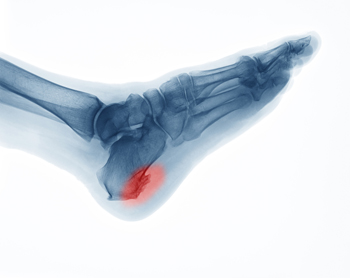 Heel spurs are small, bony growths that occur on the heel bone. When the ligament that connects the heel to the toes, known as the plantar fascia, is overstretched, pain and inflammation can result. This is due to the inflamed plantar fascia pulling on the heel bone. Over time, the body builds extra bone in this area in response to the stress, creating heel spurs. Some people who have heel spurs do not experience any symptoms, while others may feel pain and tenderness in the bottom of their heel. They may also be able to feel a bump in the bottom of their heel when pressure is applied. A heel spur can be diagnosed via an X-ray. For more information about heel spurs, consult with a podiatrist today.
Heel spurs are small, bony growths that occur on the heel bone. When the ligament that connects the heel to the toes, known as the plantar fascia, is overstretched, pain and inflammation can result. This is due to the inflamed plantar fascia pulling on the heel bone. Over time, the body builds extra bone in this area in response to the stress, creating heel spurs. Some people who have heel spurs do not experience any symptoms, while others may feel pain and tenderness in the bottom of their heel. They may also be able to feel a bump in the bottom of their heel when pressure is applied. A heel spur can be diagnosed via an X-ray. For more information about heel spurs, consult with a podiatrist today.
Heel spurs can be incredibly painful and sometimes may make you unable to participate in physical activities. To get medical care for your heel spurs, contact one of our podiatrists from New Tampa Foot & Ankle. Our doctors will do everything possible to treat your condition.
Heels Spurs
Heel spurs are formed by calcium deposits on the back of the foot where the heel is. This can also be caused by small fragments of bone breaking off one section of the foot, attaching onto the back of the foot. Heel spurs can also be bone growth on the back of the foot and may grow in the direction of the arch of the foot.
Older individuals usually suffer from heel spurs and pain sometimes intensifies with age. One of the main condition's spurs are related to is plantar fasciitis.
Pain
The pain associated with spurs is often because of weight placed on the feet. When someone is walking, their entire weight is concentrated on the feet. Bone spurs then have the tendency to affect other bones and tissues around the foot. As the pain continues, the feet will become tender and sensitive over time.
Treatments
There are many ways to treat heel spurs. If one is suffering from heel spurs in conjunction with pain, there are several methods for healing. Medication, surgery, and herbal care are some options.
If you have any questions feel free to contact our office located in Wesley Chapel, FL . We offer the latest in diagnostic and treatment technology to meet your needs.
How to Treat Heel Spurs
Heel spurs are calcium deposits that cause bone protrusions on the heel bone. Heel spurs are usually associated with plantar fasciitis, which occurs when the plantar fasciitis in the foot becomes inflamed. Typically, heel spurs don’t cause any symptoms. However, they can produce chronic or intermittent heel pain. Those who have had the condition often describe the irritation as a stabbing pain.
There are risk factors that may make you more likely to develop heel spurs. People who have abnormal walking gaits, run and jog on hard surfaces, are obese, or wear poorly fitting shoes are more likely to develop heel spurs.
Fortunately, there are precautions you can take to avoid developing heel spurs. One of the best ways to do this is by wearing well-fitting shoes with shock-absorbent soles. Another preventative technique is to choose running shoes if you plan on running, and walking shoes if you plan on walking. Shoes are made for different activities and it is important to research a shoe before you purchase a pair.
The pain associated with heel spurs often decreases the more you walk. However, a recurrence of pain after an extended period of rest or walking is likely to occur with this condition. Those with severe heel spur pain may opt to go the surgical route for treatment. However, more than 90% of those with the condition get better without surgical treatment. If you have a heel spur and want to know if surgery is right for you, you should go to your podiatrist and he or she will be able to conduct a pre-surgical test or exam to determine if you are an optimal candidate for surgery.
What Can Cause Flat Feet?
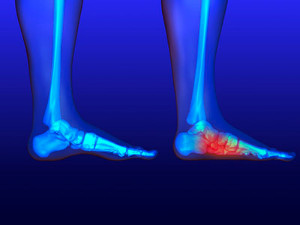 When the foot lies completely on the floor while standing barefoot, it may be indicative of a condition that is known as flat feet. The gap that is found between the arch and floor is nonexistent, and this may affect the natural gait. It can happen from genetic reasons, or possibly from an injury. There are medical conditions that may cause flat feet to develop. These can include cerebral palsy, diabetes, or obesity, which may affect the nerves. Some of the symptoms that are generally associated with this condition can consist of tired feet, pain in the heel and arch area, and it may be difficult to stand. Many patients choose to wear supportive devices in their shoes, in addition to performing stretches that can strengthen the feet. If you are afflicted with flat feet and they are causing you pain, it is suggested that you consult with a podiatrist who can recommend correct treatment methods for you.
When the foot lies completely on the floor while standing barefoot, it may be indicative of a condition that is known as flat feet. The gap that is found between the arch and floor is nonexistent, and this may affect the natural gait. It can happen from genetic reasons, or possibly from an injury. There are medical conditions that may cause flat feet to develop. These can include cerebral palsy, diabetes, or obesity, which may affect the nerves. Some of the symptoms that are generally associated with this condition can consist of tired feet, pain in the heel and arch area, and it may be difficult to stand. Many patients choose to wear supportive devices in their shoes, in addition to performing stretches that can strengthen the feet. If you are afflicted with flat feet and they are causing you pain, it is suggested that you consult with a podiatrist who can recommend correct treatment methods for you.
Flatfoot is a condition many people suffer from. If you have flat feet, contact one of our podiatrists from New Tampa Foot & Ankle. Our doctors will treat your foot and ankle needs.
What Are Flat Feet?
Flatfoot is a condition in which the arch of the foot is depressed and the sole of the foot is almost completely in contact with the ground. About 20-30% of the population generally has flat feet because their arches never formed during growth.
Conditions & Problems:
Having flat feet makes it difficult to run or walk because of the stress placed on the ankles.
Alignment – The general alignment of your legs can be disrupted, because the ankles move inward which can cause major discomfort.
Knees – If you have complications with your knees, flat feet can be a contributor to arthritis in that area.
Symptoms
- Pain around the heel or arch area
- Trouble standing on the tip toe
- Swelling around the inside of the ankle
- Flat look to one or both feet
- Having your shoes feel uneven when worn
Treatment
If you are experiencing pain and stress on the foot you may weaken the posterior tibial tendon, which runs around the inside of the ankle.
If you have any questions please feel free to contact our office located in Wesley Chapel, FL . We offer the newest diagnostic and treatment technologies for all your foot and ankle needs.
Common Foot Conditions During Pregnancy
 Certain foot conditions are common among pregnant women. Flat feet can be the cause of general foot discomfort, and the pain can range from sharp and throbbing to a dull ache. Flat feet can develop as a result of the added weight that the feet must endure. An additional condition that can occur is swollen feet, and it may be uncomfortable to wear shoes that are normally worn. Swelling may be decreased when salt intake is reduced, and it may help to elevate the feet frequently during the day. If you are pregnant and feeling pain and discomfort in your feet, it is recommended that you consult with a podiatrist for possible relief options.
Certain foot conditions are common among pregnant women. Flat feet can be the cause of general foot discomfort, and the pain can range from sharp and throbbing to a dull ache. Flat feet can develop as a result of the added weight that the feet must endure. An additional condition that can occur is swollen feet, and it may be uncomfortable to wear shoes that are normally worn. Swelling may be decreased when salt intake is reduced, and it may help to elevate the feet frequently during the day. If you are pregnant and feeling pain and discomfort in your feet, it is recommended that you consult with a podiatrist for possible relief options.
Pregnant women with swollen feet can be treated with a variety of different methods that are readily available. For more information about other cures for swollen feet during pregnancy, consult with one of our podiatrists from New Tampa Foot & Ankle. Our doctors will attend to all of your foot and ankle needs.
What Foot Problems Can Arise During Pregnancy?
One problem that can occur is overpronation, which occurs when the arch of the foot flattens and tends to roll inward. This can cause pain and discomfort in your heels while you’re walking or even just standing up, trying to support your baby.
Another problem is edema, or swelling in the extremities. This often affects the feet during pregnancy but tends to occur in the later stages.
How Can I Keep My Feet Healthy During Pregnancy?
- Wearing orthotics can provide extra support for the feet and help distribute weight evenly
- Minimize the amount of time spent walking barefoot
- Wear shoes with good arch support
- Wear shoes that allow for good circulation to the feet
- Elevate feet if you experience swelling
- Massage your feet
- Get regular, light exercise, such as walking, to promote blood circulation to the feet
If you have any questions please feel free to contact our office located in Wesley Chapel, FL . We offer the newest diagnostic and treatment technologies for all your foot and ankle needs.
Foot Conditions That May Improve From Wearing Orthotics
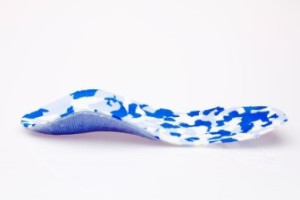 Orthotics are defined as insoles that are worn inside shoes. Custom-made orthotics may be helpful in alleviating foot pain that comes from having flat feet, plantar fasciitis, or specific ankle conditions. They may be able to provide healthy muscle activity which can make the feet feel better. Additionally, orthotics can offer adequate shock absorption, and may be able to give an arch to patients that have flat feet. Orthotics can be beneficial in helping patients successfully accomplish daily activities. If you would like additional information about the benefits of wearing orthotics, it is suggested that you speak to a podiatrist who can determine if they are right for you.
Orthotics are defined as insoles that are worn inside shoes. Custom-made orthotics may be helpful in alleviating foot pain that comes from having flat feet, plantar fasciitis, or specific ankle conditions. They may be able to provide healthy muscle activity which can make the feet feel better. Additionally, orthotics can offer adequate shock absorption, and may be able to give an arch to patients that have flat feet. Orthotics can be beneficial in helping patients successfully accomplish daily activities. If you would like additional information about the benefits of wearing orthotics, it is suggested that you speak to a podiatrist who can determine if they are right for you.
If you are having discomfort in your feet and would like to try orthotics, contact one of our podiatrists from New Tampa Foot & Ankle. Our doctors can provide the care you need to keep you pain-free and on your feet.
What Are Orthotics?
Orthotics are inserts you can place into your shoes to help with a variety of foot problems such as flat feet or foot pain. Orthotics provide relief and comfort for minor foot and heel pain but can’t correct serious biomechanical problems in your feet.
Over-the-Counter Inserts
Orthotics come in a wide variety of over-the-counter inserts that are used to treat foot pain, heel pain, and minor problems. For example, arch supports can be inserted into your shoes to help correct overarched or flat feet, while gel insoles are often used because they provide comfort and relief from foot and heel pain by alleviating pressure.
Prescription Orthotics
If over-the-counter inserts don’t work for you or if you have a more severe foot concern, it is possible to have your podiatrist prescribe custom orthotics. These high-quality inserts are designed to treat problems such as abnormal motion, plantar fasciitis, and severe forms of heel pain. They can even be used to help patients suffering from diabetes by treating foot ulcers and painful calluses and are usually molded to your feet individually, which allows them to provide full support and comfort.
If you are experiencing minor to severe foot or heel pain, it’s recommended to speak with your podiatrist about the possibilities of using orthotics. A podiatrist can determine which type of orthotic is right for you and allow you to take the first steps towards being pain-free.
If you have any questions please contact our office located in Wesley Chapel, FL . We offer the newest diagnostic and treatment technologies for all your foot and ankle needs.
Does My Child Have a Broken Toe, or Something Else?
When your child has a toe injury, you may be concerned that it is a broken bone. Broken toe bones share common symptoms, such as pain, swelling, and bruising, with various other injuries. Cuts, scrapes, or bruises on the toe are all very common injuries, as are stubbed toes. Crushed or smashed toes can occur if something heavy has fallen on the foot. A toenail injury or a blood clot under the nail may be painful and require treatment by a doctor to release pressure under the nail or to prevent a deformity in the nail. Dislocations, which occur when the toe is pushed out of its joint, can cause pain, swelling, and bruising as well. If you suspect that your child may have a broken toe, or if you suspect that they have another condition and it is causing them pain, it is suggested that you take them to a podiatrist for treatment.
A broken toe can be very painful and lead to complications if not properly fixed. If you have any concerns about your feet, contact one of our podiatrists from New Tampa Foot & Ankle. Our doctors will treat your foot and ankle needs.
What to Know About a Broken Toe
Although most people try to avoid foot trauma such as banging, stubbing, or dropping heavy objects on their feet, the unfortunate fact is that it is a common occurrence. Given the fact that toes are positioned in front of the feet, they typically sustain the brunt of such trauma. When trauma occurs to a toe, the result can be a painful break (fracture).
Symptoms of a Broken Toe
- Throbbing pain
- Swelling
- Bruising on the skin and toenail
- The inability to move the toe
- Toe appears crooked or disfigured
- Tingling or numbness in the toe
Generally, it is best to stay off of the injured toe with the affected foot elevated.
Severe toe fractures may be treated with a splint, cast, and in some cases, minor surgery. Due to its position and the pressure it endures with daily activity, future complications can occur if the big toe is not properly treated.
If you have any questions please feel free to contact our office located in Wesley Chapel, FL . We offer the newest diagnostic and treatment technologies for all your foot and ankle needs.
